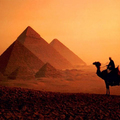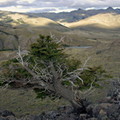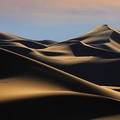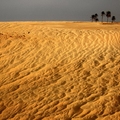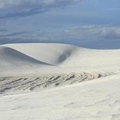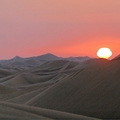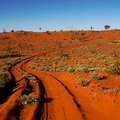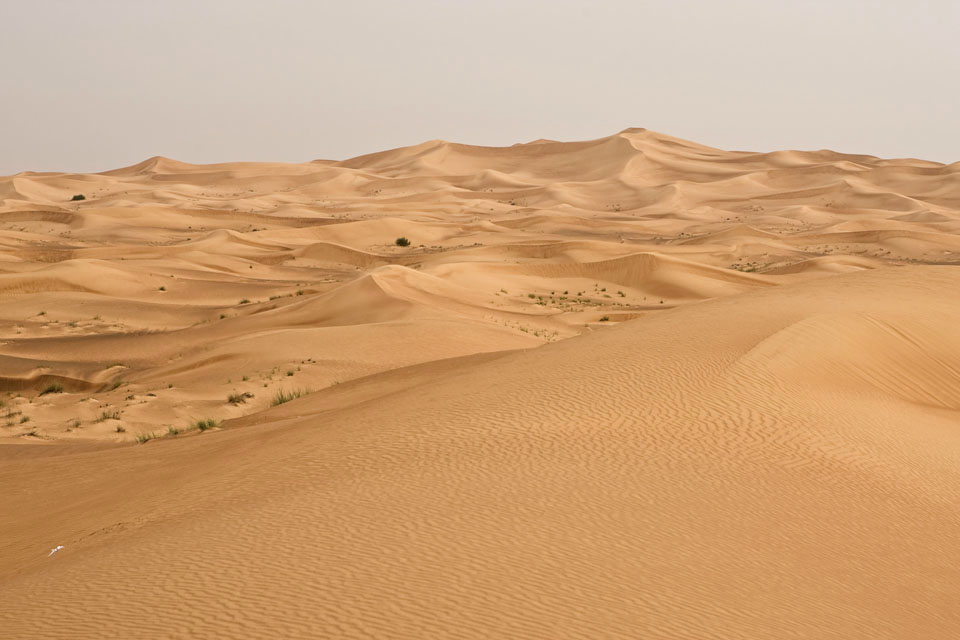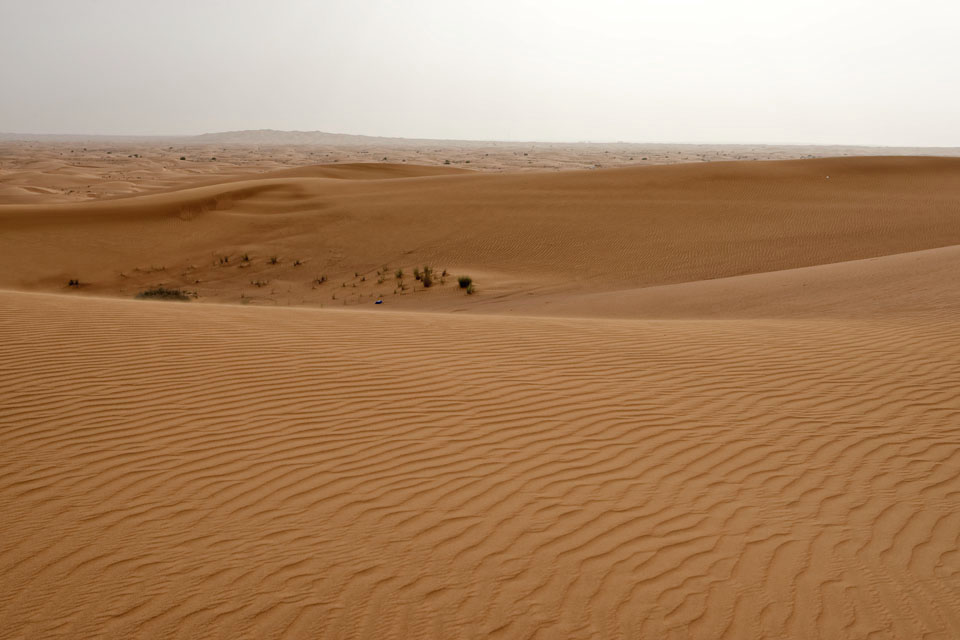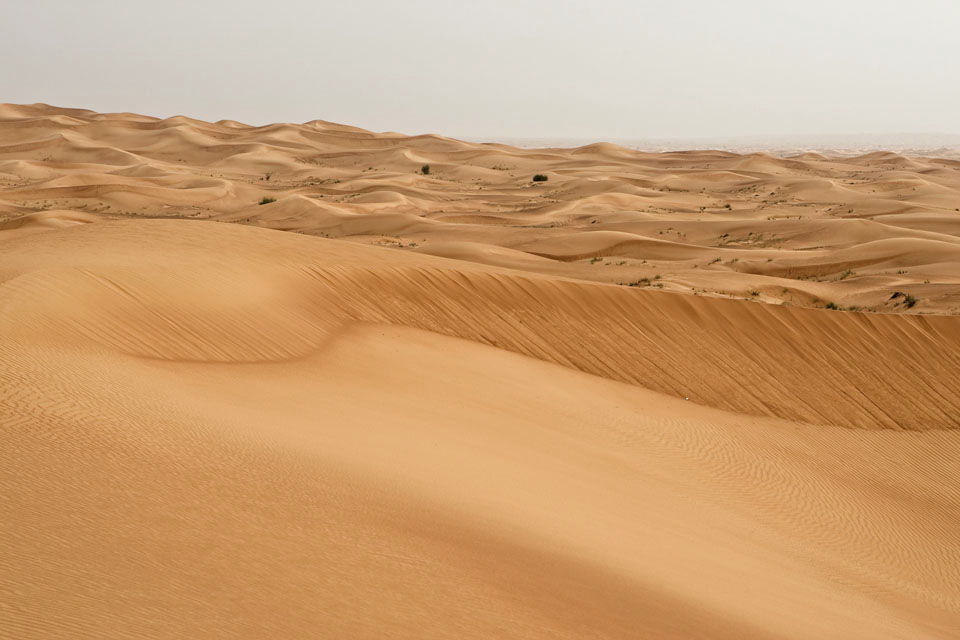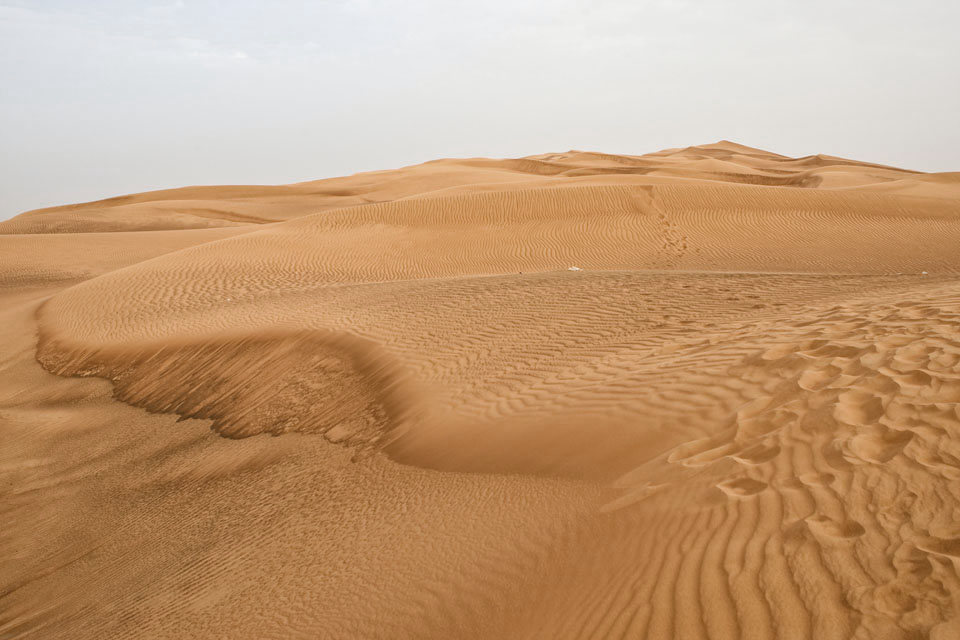Eco-friendly locations / The Largest Deserts in the World / The Arabian Desert
The Arabian Desert
The Arabian Desert is a vast desert area that goes from Yemen to the Persian Gulf , from the Oman to Jordan and to Iraq . The desert occupies most of the Arabian Peninsula and stretches over 222,070 square km. The Rub 'al-Khali houses at the center and it is one of the largest stretches of sand on the planet. Its fauna includes gazelles, oryx , sand cat , lizard, uromastyx , and more others. The climate is very dry and with high daytime temperatures ranging from overnight frosts and winter. There are big, red, sand dunes and shifting sands. They are part of the biome -arid desert-steppe and of the ' Palearctic ecozones . This ecoregion holds little biodiversity, although few endemic plants grow in these parts. Many species such as Hyaena hyaena , the jackaland badger capensis have become extinct due to hunting and due to the habitat destruction. Other species have been re-introduced successfully as the sand gazelle. Overgrazing, off-road driving and destruction of habitat by man are the major threats to this desert eco-region.
Detailed description
Most of the desert of the Rub 'al-Khali is a hyper-arid region. The rainfall is of only 35 mm per year and the humidity reaches 50% in winter and 15% in summer. The temperatures range from 40 ° C to 50 ° C degrees in summer, with average winter temperatures between 5 ° degrees C and 15 ° C with the minimum that can even drop below 0 ° C. The ' Saudi Arabia records temperatures cooler in summer, around 30 ° C, and winter temperatures around 5 ° C with average rainfall of 80 mm.
Detailed geological features
A corridor of sand dunes known as the Desert of Ad-Dahna desert connects the northern Nefud (65,000 square miles) with the greatest of the Rub 'al-Khali in the south-east.
The Tuwayk is a region of 800 km formed by cliffs of sedimentary rock , plateaus and canyons.
Brackish salt plains: the quick sands of Umm al Samim .
The Wahiba Sands of Oman : isolated desert dunes located on the east coast.
The Rub 'al-Khali is a desert in a sedimentary basin that extends from the south-west to the north-east of the Arabian plateau in the middle. The rocky landscape gives way to the sandy desert of ar-Ruba'Al-Khali in the south end through the center of Yemen . The sands of this desert lie on a base of gravel and chalk and the dunes reach a maximum height of 250 meters. The sand grains are mainly composed of silicates: 80-90% of quartz and the rest from mineral calcium, potassium or sodium. Their red, orange or purple stems of iron oxide coats the grains of sand on the outside.
Ecology and Natural Resources
Some resources are: petroleum , gas , phosphate and sulfur . The Rub'al-Khali has a very limited floral biodiversity . There are only 37 species of flora, 20 of which are located in the sandy desert and the other 17 on the edge of it. The vegetation is very rare but evenly distributed with some interruptions on the barren sands of the dunes. Some typical plants are:
Calligonum crinitium on the slopes of the dunes
Cornulaca Arabic (also called the "salt bush")
Cyperus conglomeratus
Other common plants are:
Dipterygium glaucum
Limeum arabicum
Zygophyllum mandavillei
Few trees can be found in the desert with a few exceptions to the boundaries of it (typically ehrenbergiana Acacia and the Prosopis cineraria ). Other species are the shrub Calligonum comosum and annual herbs such as Danthonia forskallii .
Political boundaries
The desert is found mainly in Saudi Arabia and extends in neighboring Egypt ( the Sinai Peninsula ), southern Iraq , southern Jordan and Saudi Arabia . The Arabian Desert is bordered by 5 countries. The desert near the Persian Gulf includes part of Qatar and most of the Abu Dhabi in United Arab Emirates (UAE). The main desert Rub 'al-Khali extends west from the Oman to the east and Yemen .
People, language and culture
The predominant religions are the Shiism and Sunnism . The largest ethnic group in the area are the Arabs - speaking Arab .
Environmental threats
Excessive grazing of goats and camels, with the size of growing herds, and increasingly sedentary lifestyle of the Bedouins .
Excessive off-road driving
Destruction of habitats
Agriculture
Production of oil and natural gas
Wars and their consequences
Oil spills
This eco-region was the scene of a vast economic and environmental sabotage on the part of Iraq to the detriment of the oil fields of Kuwait which once sabotaged and caused the loss of various toxins in the atmosphere in 1990. In 1991 during the Gulf War 's Iraq dumped in the sea of the Persian Gulf about 1.7 million barrels of oil. In February of that year 1,164 oil wells had been destroyed, Kuwaitis , and then it took nine months to extinguish the flames from the pits. These oil spills contaminated about 1,000 km of the coastline of the Persian Gulf . The results of this pollution were the deaths of thousands of waterfowls and serious damage to the marine ecosystem of the Persian Gulf, especially crabs , turtle seas, dugongs , whales , dolphins and fish in general. The damaged oil wells released 10 million cubic meters (60 million barrels) of oil in the desert and formed lakes (with a total area of 49 km ²) that contaminated the soil and the groundwater. Pollution also caused great armaments used by the troops of the United States with their columns of tanks destroying the fragile environmental balance in their areas of transit. In 1991 a column of tanks stirred the thin protective coat of land which formed the floor of the desert. Doing so caused the beginning of a sand dune that slowly began to roll downhill. Some people are alarmed because they believe that this dune could then reach Kuwait City .Another concern are the weapons to depleted uranium used by the United States with A-10 Thunderbolt II . It is known that DU weapons produce cancer and contaminate aquifers. In 1991 the United States and NATO dumped about 300 tons of depleted uranium in Iraq . The fragments that explosed by these bombs with depleted uranium contaminated the surrounding soil to them. The species of oryx and the white gazelle of the sand were endangered while the jackal , the hyaena and badger capensis are already extinct. There is no park but it is being currently planned for the future in a state of Abu Dhabi .
Others The Largest Deserts in the World .
Maps of The Arabian Desert
mapOthers from The Largest Deserts in the World
Under such dry conditions it is hard for the plants to live and the soils to form.
There is anything that protects the earth from overheating in these areas.
The hottest place on the Earth is the tropical desert, but there are coldest , even icy deserts, for instance, Antarctica.
Deserts cover approximately 20% of the Earth's land surface and 80% in Australia , therefore, a fifth of the Earth's land area belongs to the deserts.
Many of the major deserts are located near the tropics, such as the Sahara desert which is the largest desert in the world, as well as the Kalahari, the Namib Desert and the Grand Victoria in Australia.
Droughts During the grazing of cattle during droughts disorders of vegetation occur.
They are so significant that are likely unrecovered.
The sun's rays quickly dry the soil and turn to dust, which happens to desertification, a continuous transformation of the land in the desert.
A desert with a change in climatic conditions can always shrink and expand.
The long-term global climate change or contraction of the continents can garden the desert or turn it into a magnificent forest.
Short-lived changes in weather conditions influence the expansion of its borders, turning occasionally green areas in arid deserts.
The hottest places on the Earth are the tropical desert, where the daytime temperatures often reach +50 ° C.
This heat can destroy the stones and give the landscape an unusual character.
The underground water evaporates so quickly that minerals are dissolved from the crust.
Deserts are constantly dry, but in other natural areas prolonged dry periods can occur - the droughts.
Their presence in any place depends on what kind of rainfall is there.
There was a drought in Sahel, Africa, that lasted many months without rain.
However, droughts are regular and in some places they are with a typical moisture content, such as the North American grasslands which dry up every 22 years.
Water plays a significant role in shaping the dry landscape, despite of its low quantity in the desert .
Water alters the chemical composition of rocks, now and then it is dumped in the desert from the sky, at times becoming the cause of short, but strong flash floods, which are harmful to the soil.
Do all the deserts have very high temperatures and a lot of sand? We call a desert an area where not more than 25 inches of rain falls per year.
As a rule, deserts are formed in the hot desert climates, but there are exceptions.
Most deserts have a lot of rocks and stones and sand.
What is the biggest desert? The most extensive deserts are located in areas of high atmospheric pressures.
All the winds blow in areas of their inner regions, but the moist winds from the sea reach them very rarely.
There are those deserts, which are near the sea, and yet the sea winds will reach them, they lose most of moisture on the way.
Certain deserts are formed on the internal continental slopes of mountain ranges, well sheltered from the sea winds.
Almost all of Antarctica is a huge frozen desert, which is located in an area of high pressure, so that its interior is extremely small drops of fresh snow.
The driest desert in the world.
In many deserts there is no rain for several years in a row, then a short downpour happens and everything starts all over again.
The most arid desert is the Atacama Desert in South America .
Until 1971, there were 400 years without spilling a drop.
It is known that in several places in the desert, there are artesian waters, but the high boron content makes them unsuitable for irrigation.
What is an oasis? An oasis is a plot of land in the desert, which is covered with vegetation.
It feeds from underground springs or natural wells.
The largest desert in the world The largest desert in the world is the Sahara Desert in North Africa.
Its area is of approximately 8400 sq.
km.
However, only ten percent of its territory is covered with sand, and everything else is taken by bare rocks and stones.
After Sahara, we have the Arabian desert, the Gobi, the Patagonian,the Rub’ al Khali, the Great Victoria, the Kalahari, the Great Basin, the Chihuahuan and the Thar.

